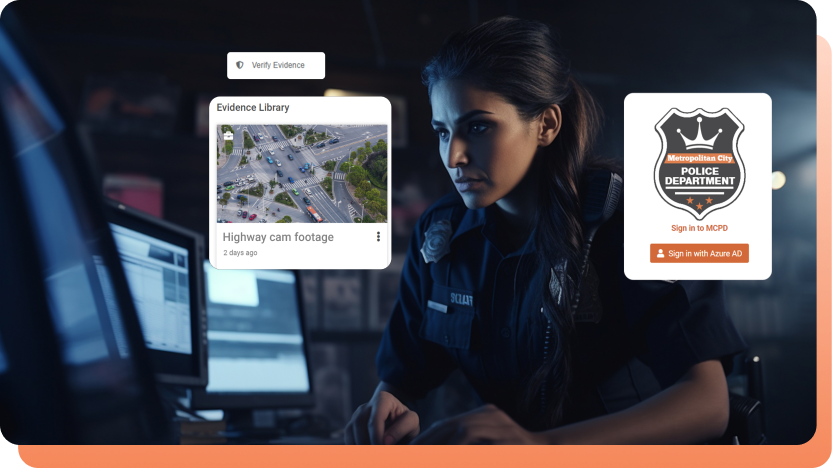A Complete Guide to the Types of Digital Evidence Used in Modern Law Enforcement
By Ali Rind on Nov 14, 2025 9:40:20 AM

Digital evidence has become the backbone of modern policing. With nearly every crime involving some form of digital footprint—whether a mobile phone, surveillance camera, or social media account—agencies must understand what types of digital evidence exist and how to handle them properly.
This guide breaks down the major types of digital evidence used today, why each matters, and how law enforcement can manage them securely and efficiently using advanced digital evidence management practices.
What Is Digital Evidence?
Digital evidence refers to any information stored or transmitted in digital form that is relevant to an investigation. Unlike physical evidence, digital data is easily duplicated, altered, or deleted—making secure handling, tamper-proof storage, and verified chain of custody critical for legal admissibility.
Modern Digital Evidence Management platforms support this by providing secure storage, automated audit trails, access management, and encryption.
Key Types of Digital Evidence in Modern Law Enforcement
1. Video Evidence
Video is the most widely used and most requested type of digital evidence in investigations.
Common sources include:
- Body-worn cameras
- Dashboard cameras
- Interview room recordings
- CCTV and public surveillance
- Mobile phone video recordings
Why it matters:
Video provides a factual, visual account of incidents and can help identify suspects, verify witness statements, and reconstruct events.
How Digital Evidence Management System supports it:
- Secure ingestion from multiple devices
- Automated metadata extraction
- AI-based object detection and redaction
- Role-based access and tamper-proof storage
2. Audio Evidence
Audio captures conversations, emergency communications, and surrounding sounds, offering relevant data.
Sources include:
- 911 call recordings
- Interview room audio
- Wiretaps (court-authorized)
- Voice memos
How it helps investigations:
Audio can reveal threats, identify speakers, and provide timelines.
Digital Evidence Management System capabilities supporting audio:
- Speech-to-text transcription
- Keyword-based search
- Secure playback and chain-of-custody control
3. Image Evidence
Still images capture moments that video or audio might miss.
Sources include:
- Crime scene photographs
- CCTV snapshots
- Social media images
- Drone-captured photos
- Mobile phone pictures
Why it is essential:
Images help document scenes, highlight injuries, capture objects, and preserve evidence conditions.
DEMS benefits:
- Metadata preservation (EXIF, timestamps)
- Secure sharing with investigators and prosecutors
- Classification and tagging for easy retrieval
4. Mobile Device Data
Smartphones are now considered “digital diaries”—containing personal, location, communication, and behavioral data.
Data types extracted:
- Call logs, messages, and emails
- Photos, videos, and app data
- GPS and location history
- Browser history
- Social media activity
Why it matters:
Mobile data provides precise timelines, communication patterns, and geolocation evidence.
Digital Evidence Management System strengthens mobile data handling through:
- Secure ingestion of forensic extractions
- Segregated access control
- Audit logs for every action taken
5. Drone Footage
Drone video is increasingly used for crime scene documentation and surveillance.
Use cases:
- Accident reconstruction
- Crime scene mapping
- Large-area search
Digital Evidence Management System advantage:
- Handling of large, high-resolution drone video files
- AI search features for quick evidence review
Best Practices for Managing All Types of Digital Evidence
To keep digital evidence secure, admissible, and easy to share when necessary, law enforcement agencies should follow best practices such as:
- Maintaining a strict chain of custody
- Using AES-256 encryption during storage, transfer, and secure digital evidence sharing
- Automating metadata capture
- Using AI for redaction and object detection
- Using centralized DEMS platforms for entire lifecycle management and sharing digital evidence across authorized stakeholders
- Ensuring permissions-based access control
- Preserving original file integrity
These practices are supported by advanced digital evidence management solutions, helping agencies enable secure digital evidence sharing, reduce manual work, prevent evidence loss, and accelerate case resolution.
Key Takeaways
- Modern digital evidence includes video, audio, images, mobile data, IoT logs, social media content, and more.
- Each type offers unique investigative value and must be handled securely to remain admissible in court.
- DEMS platforms support law enforcement by providing secure storage, automated chain of custody, AI-driven analytics, and access control.
- Centralizing all digital evidence types prevents loss, accelerates investigations, and supports inter-agency collaboration.
- Ensuring compliance through encryption, redaction, and audit trails is essential for handling sensitive evidence.
Managing Digital Evidence the Right Way
Digital evidence is now central to every investigation, but its complexity demands the right tools and workflows. A modern Digital Evidence Management System ensures that every file—whether video, mobile data, or social media content—remains secure, traceable, and ready for use in court.
If your agency wants to manage digital evidence more effectively, improve security, and streamline investigative workflows, start exploring VIDIZMO’S secure Digital Evidence Management System today. You can also request a free trial or consult with experts to see how a centralized platform can transform your evidence operations.
People Also Ask
What are the main types of digital evidence used in law enforcement?
The main types of digital evidence include video recordings, audio files, mobile device data, images, social media content, and cloud-based information. These provide crucial insights for investigations.
Why are different types of digital evidence important in criminal cases?
Different types of digital evidence offer complementary perspectives on a case, helping investigators reconstruct events, verify timelines, and establish connections that physical evidence alone cannot provide.
How do agencies manage the types of digital evidence collected today?
Agencies use secure digital evidence management practices, including encrypted storage, access controls, audit trails, and centralized platforms that organize and protect all evidence types from capture to courtroom presentation.
Which types of digital evidence come from smartphones?
Smartphones generate call history, messages, app data, photos, videos, GPS logs, and browsing activity. This information forms a significant portion of modern digital evidence and helps investigators establish communication patterns and locations.
How is video considered a type of digital evidence in investigations?
Video evidence from bodycams, CCTV, dashboard cameras, and phones provides visual proof of events, allowing investigators to analyze movements, behavior, and timelines with greater accuracy.
What challenges exist when handling multiple types of digital evidence?
Challenges include large file sizes, format compatibility issues, chain-of-custody risks, data privacy requirements, and the need for secure inter-agency sharing. Centralized evidence management helps solve these issues.
How does metadata support different types of digital evidence?
Metadata adds critical context such as timestamps, device identifiers, locations, and user actions. This information strengthens authenticity and helps investigators verify the origin and integrity of each evidence file.
What role does cloud data play as digital evidence?
Cloud data includes emails, stored documents, backups, and communication logs. It helps investigators track digital activity across devices and platforms while preserving original file structures.
Can social media content be used as digital evidence in court?
Yes, posts, messages, comments, photos, and live streams from social media platforms are accepted as digital evidence when properly collected and authenticated according to legal protocols.
Jump to
You May Also Like
These Related Stories

The IACP Guidelines for Digital Evidence Management

Essential Digital Evidence Management System Features to Look For



No Comments Yet
Let us know what you think